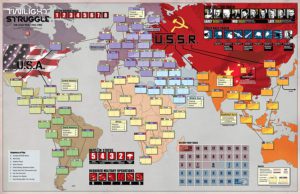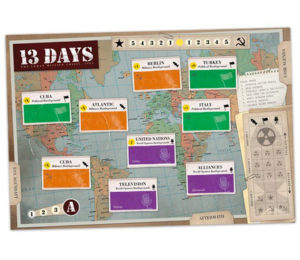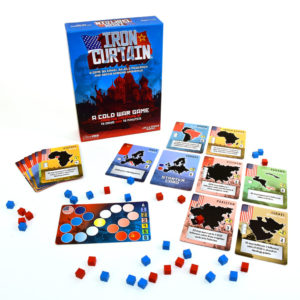
Scaling Experiences
Often we want students or participants to experience something compelling or engaging, but we do not have enough time or space allotted for the full experience. Even a moderately complex board game can take several hours to setup, learn and play. Which is well out of the range of most group events we can easily organize.
It has been noted elsewhere that games can help us learn subjects such as history. But one could teach an entire course on the Cold War, so how can games help us approach these complicated subjects and also drive student or participant conversations?
Let’s look at how four different tabletop games approach the Cold War as a subject, and how they scale their differing level of experiences.
Twilight Struggle is a multiple award-winning board game, and more specifically, a card-driven strategy game, from designers Ananda Gupta and Jason Matthews. It was published by GMT Games in 2005, and until recently it was the most popular tabletop game out over over 100,000 games on the popular board game review site BoardGameGeek.
Twilight Struggle simulates the Cold War (1945-1989) on a strategic level. The game features a large board with card-driven mechanics, and counters to track game states. The rules are considered medium from a wargamer’s perspective, but they are more advanced for someone used to casual games such as Settlers of Catan. It is a two-player game that takes about 2-3 hours hours to play if you are familiar with the rules.
The cards are used both to trigger events in the game, and to place influence in certain countries. Each country other than the US and Soviet Union have a Stability Number and space for Influence markers. To simulate the different potential events happening over the decades, the game is split into “Early/Mid/Late War”, with additional cards being added to the deck for Mid War and Late War periods. Some card examples are:
- Early War
- Warsaw Pact Formed
- Nuclear Test Ban
- Olympic Games
- Mid War
- Cuban Missile Crisis
- Camp David Accords
- Sadat Expels Soviets
- Late War
- Iran-Contra Scandal
- Glasnost
- Marine Barracks Bombing
There are 110 cards in the game, and just by setting up the board and reading through the cards, participants can get a good sense of what the game is about, and perhaps learn some things about the Cold War that they did not know.
But what to do if there is not enough time or space to play?
13 Days is a strategic game designed by Asger Harding Granerud and Daniel Skjold Pedersen and published by Jolly Roger Games. It takes a much more condensed look at the Cold War through the lens of the Cuban Missile Crisis in 1962. It has a smaller board that uses regions instead of countries, and while it has card-driven mechanics like Twilight Struggle, it has half the number of cards and uses a smaller set of markers and cubes instead of the more detailed counters of Twilight Struggle.
A review in the Cardboard Republic says, “This game distills what makes Twilight Struggle so enjoyable into a palatable 45 minute focus on a single Cold War event, all while still offering plenty of intrigue and replayability in its own right.” (http://jollyrogergames.com/game/13-days/)
From the game rules:
During the game, you earn Prestige by dominating the nine different battlegrounds around the globe or by dominating the political, military or world opinion arenas.
Players take turns playing Strategy cards to place or remove Influence cubes, striving to gain majorities across the Game board. The tricky part is: if you push too far, you risk losing the game by triggering global nuclear war!
30-45 minutes to play
Iron Curtain is a small fast-playing game designed by Asger Harding Granerud and Daniel Skjold Pedersen and published by Jolly Roger Games, and is set during the Cold War. Players take on the roles of the superpowers as they attempt to dominate regions and battlegrounds, asserting influence so that victory ends up within their political reach.
“Feels like a lightning version of Twilight Struggle, minus a few key mechanics, most notably a space race.” (https://www.druidcitygames.com/board-game-spotlight/2017/9/24/iron-curtain-influencing-the-world-one-cube-at-a-time)
While this game is similar in play time to 13 Days, they differ in that Iron Curtain is attempting to show the whole scope of the Cold War, while 13 Days is looking at the Cold War through the lens of the Cuban Missile Crisis.
Card-laying to create the board feels different than playing on a map where the country positions are already set. The mechanic has the result of feeling like you are trying to outmaneuver your opponent, and adds to the replay value of the game.
13 Minutes is a card-driven game designed by Asger Harding Granerud and Daniel Skjold Pedersen and published by Jolly Roger Games with tough decisions. Playing as either President Kennedy or Khrushchev, your aim is to exit the Cuban Missile Crisis as the most powerful superpower.
This is a very stripped down game, that notes it can be played in “13 minutes”. But how does it do this?
“13 Minutes faces the daunting task of delivering a microgame that maintains the feel of 13 Days or Twilight Struggle, which are known for their intense, serious gameplay. With the huge caveat “for a microgame,” it succeeds; and it does this by maximizing every aspect of each card. Cards can be played as events or for influence cubes, but once played, they become territories on the board to fight over, and the player has a choice as to where to play the territory. For the most part, the game is just about controlling more territories than your opponent, but if you have three territories of the same color in your sphere of influence (even if you do not control them), you instantly lose! This is an extremely condensed representation of the DEFCON tracks used in 13 Days. Also similar to 13 Days, drawing your opponent’s event means you have to let them have it before you play the card for influence cubes, creating a modicum of tension.” (http://www.geeksundergrace.com/tabletop/reviews-tabletop/review-13-minutes-cuban-missile-crisis/)
So, what do we learn about scaling experiences from looking at these four games?
- Twilight Struggle is itself an extreme simplification of the Cold War experience in a board game format. But in setting it up and playing it, especially several times, one can get a sense of the zeitgeist of the times and learn the many factors that made it such a fascinating time in world history. It is also very playable and rewards multiple sessions to seek out the intricacies in the rules. It is playable in 2-3 hours.
- 13 Days distills the game experience down to a single event, the Cuban Missile Crisis. But it deals with it from a global perspective instead of merely regional. It is playable in 30-45 minutes.
- Iron Curtain eschews the board for a card-laying game and showcases the entire Cold War, albeit from a higher level and with less detail and fewer mechanics. It is playable in 20-30 minutes.
- 13 Minutes also uses cards instead of a game board, and attempts to show a very high level take on the Cuban Missile Crisis. It is playable in 13 minutes.
It is possible to fit games and other types of interactive experiences into the time allotted by adding or subtracting complexity and mechanics from the proposed agenda.
Some richness may be lost in the translation, but we should also ask “what are the key elements we are trying to teach?” For certain students, simply understanding that The Cuban Missile Crisis was a lens to look at a particularly dangerous time in the Cold War may be enough. Especially with a game or other experience that will showcase the inherent tension between both sides.
As always, it is critical to look at what the intended outcomes are for our lesson or our event. What do we want people to learn? What do we want them to experience or feel?




